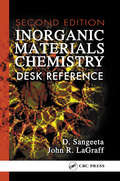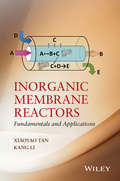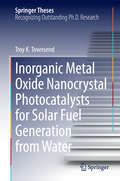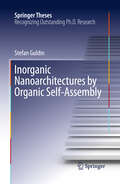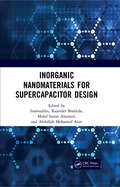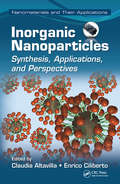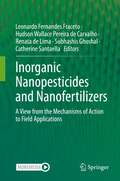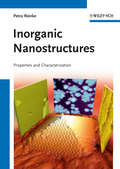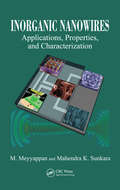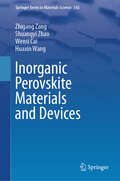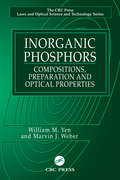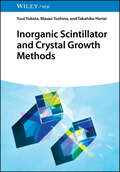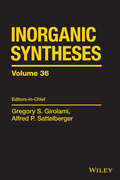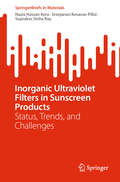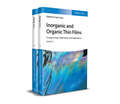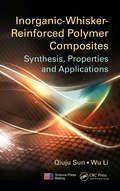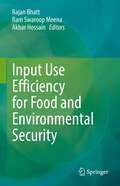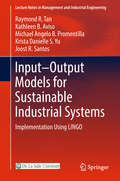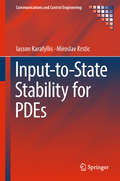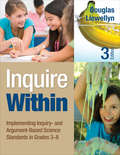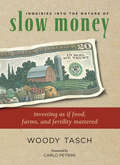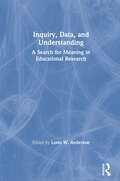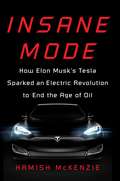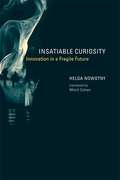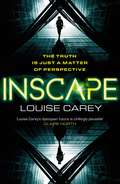- Table View
- List View
Inorganic Materials Chemistry Desk Reference
by D. Sangeeta John R. LaGraffThe updated second edition of the popular Inorganic Materials Chemistry Desk Reference remains a valuable resource in the preparation of solid-state inorganic materials by chemical processing techniques. It also expands upon new chemical precursors available to materials scientists, the applications of those materials, and existing or emerging topi
Inorganic Membrane Reactors
by Xiaoyao Tan Kang LiMembrane reactors combine membrane functions such as separation, reactant distribution, and catalyst support with chemical reactions in a single unit. The benefits of this approach include enhanced conversion, increased yield, and selectivity, as well as a more compact and cost-effect design of reactor system. Hence, membrane reactors are an effective route toward chemical process intensification. This book covers all types of porous membrane reactors, including ceramic, silica, carbon, zeolite, and dense metallic reactors such as Pd or Pd-alloy, oxygen ion-conducting, and proton-conducting ceramics. For each type of membrane reactor, the membrane transport principles, membrane fabrication, configuration and operation of membrane reactors, and their current and potential applications are described comprehensively. A summary of the critical issues and hurdles for each membrane reaction process is also provided, with the aim of encouraging successful commercial applications. The audience for Inorganic Membrane Reactors includes advanced students, industrial and academic researchers, and engineers with an interest in membrane reactors.
Inorganic Metal Oxide Nanocrystal Photocatalysts for Solar Fuel Generation from Water
by Troy K. TownsendTroy Townsend's thesis explores the structure, energetics and activity of three inorganic nanocrystal photocatalysts. The goal of this work is to investigate the potential of metal oxide nanocrystals for application in photocatalytic water splitting, which could one day provide us with clean hydrogen fuel derived from water and solar energy. Specifically, Townsend's work addresses the effects of co-catalyst addition to niobium oxide nanotubes for photocatalytic water reduction to hydrogen, and the first use of iron oxide 'rust' in nanocrystal suspensions for oxygen production. In addition, Townsend studies a nickel/oxide-strontium titanate nanocomposite which can be described as one of only four nanoscale water splitting photocatalysts. He also examines the charge transport for this system. Overall, this collection of studies brings relevance to the design of inorganic nanomaterials for photocatalytic water splitting while introducing new directions for solar energy conversion.
Inorganic Nanoarchitectures by Organic Self-Assembly
by Stefan GuldinMacromolecular self-assembly - driven by weak, non-covalent, intermolecular forces - is a common principle of structure formation in natural and synthetic organic materials. The variability in material arrangement on the nanometre length scale makes this an ideal way of matching the structure-function demands of photonic and optoelectronic devices. However, suitable soft matter systems typically lack the appropriate photoactivity, conductivity or chemically stability. This thesis explores the implementation of soft matter design principles for inorganic thin film nanoarchitectures. Sacrificial block copolymers and colloids are employed as structure-directing agents for the co-assembly of solution-based inorganic materials, such as TiO_2 and SiO_2. Novel fabrication and characterization methods allow unprecedented control of material formation on the 10 - 500 nm length scale, allowing the design of material architectures with interesting photonic and optoelectronic properties.
Inorganic Nanomaterials for Supercapacitor Design
by Inamuddin Mohd Imran Ahamed Abdullah Mohamed Asiri Rajender BoddulaAmong electrode materials, inorganic materials have received vast consideration owing to their redox chemistry, chemical stability, high electrochemical performance, and high-power applications. These exceptional properties enable inorganic-based materials to find application in high-performance energy conversion and storage. The current advances in nanotechnology have uncovered novel inorganic materials by various strategies and their different morphological features may serve as a rule for future supercapacitor electrode design for efficient supercapacitor performance. Inorganic Nanomaterials for Supercapacitor Design depicts the latest advances in inorganic nanomaterials for supercapacitor energy storage devices. Key Features: Provides an overview on the supercapacitor application of inorganic-based materials. Describes the fundamental aspects, key factors, advantages, and challenges of inorganic supercapacitors. Presents up-to-date coverage of the large, rapidly growing, and complex literature on inorganic supercapacitors. Surveys current applications in supercapacitor energy storage. Explores the new aspects of inorganic materials and next-generation supercapacitor systems.
Inorganic Nanoparticles: Synthesis, Applications, and Perspectives (Nanomaterials and their Applications)
by Claudia Altavilla Enrico CilibertoAmong the various nanomaterials, inorganic nanoparticles are extremely important in modern technologies. They can be easily and cheaply synthesized and mass produced, and for this reason, they can also be more readily integrated into applications. Inorganic Nanoparticles: Synthesis, Applications, and Perspectives presents an overview of these special materials and explores the myriad ways in which they are used. It addresses a wide range of topics, including: Application of nanoparticles in magnetic storage media Use of metal and oxide nanoparticles to improve performance of oxide thin films as conducting media in commercial gas and vapor sensors Advances in semiconductors for light-emitting devices and other areas related to the energy sector, such as solar energy and energy storage devices (fuel cells, rechargeable batteries, etc.) The expanding role of nanosized particles in the field of catalysis, art conservation, and biomedicine The book’s contributors address the growing global interest in the application of inorganic nanoparticles in various technological sectors. Discussing advances in materials, device fabrication, and large-scale production—all of which are urgently required to reduce global energy demands—they cover innovations in areas such as solid-state lighting, detailing how it still offers higher efficiency but higher costs, compared to conventional lighting. They also address the impact of nanotechnology in the biomedical field, focusing on topics such as quantum dots for bioimaging, nanoparticle-based cancer therapy, drug delivery, antibacterial agents, and more. Fills the informational gap on the wide range of applications for inorganic nanoparticles in areas including biomedicine, electronics, storage media, conservation of cultural heritage, optics, textiles, and cosmeticsAssembling work from an array of experts at the top of their respective fields, this book delivers a useful analysis of the vast scope of existing and potential applications for inorganic nanoparticles. Versatile as either a professional research resource or textbook, this effective tool elucidates fundamentals and current advances associated with design, characterization, and application development of this promising and ever-evolving device.
Inorganic Nanopesticides and Nanofertilizers: A View from the Mechanisms of Action to Field Applications
by Leonardo Fernandes Fraceto Renata De Lima Hudson Wallace Pereira de Carvalho Subhashis Ghoshal Catherine SantaellaThis book discusses inorganic/metallic nanopesticides and fertilizers. Rather than providing a general review of the topic, it offers a critical assessment of what has been achieved and highlights future measures to allow agriculture to profit from the properties of inorganic nanoparticles. It covers a variety of topics, including strategies for preparing cost-effective nanoparticles, their chemistry both within and outside the plant, the effects of nanoparticles in the field and whether the current strategies were successful in increasing crop yields. This book will appeal to readers in academia and industry, as well as stakeholders and anyone who has an interest in the applications of inorganic nanopesticides and nanofertilizers as well as the potential use of these technologies in agriculture.
Inorganic Nanostructures
by Petra ReinkeThis monograph for young researchers and professionals looking for a comprehensive reference offers an advanced treatment of the topic that extends beyond an introductory work. As such, it systematically covers the inorganic nanostructures in the breadth needed, while presenting them together with the surface science tools used to characterize them, such as electron spectroscopy and scanning probe techniques. The unique challenges in the fabrication of nanostructures are illustrated, and set into context of controlling structure, dimensionality and electronic properties.
Inorganic Nanowires: Applications, Properties, and Characterization (Nanomaterials and their Applications)
by M. Meyyappan Mahendra K. SunkaraAdvances in nanofabrication, characterization tools, and the drive to commercialize nanotechnology products have contributed to the significant increase in research on inorganic nanowires (INWs). Yet few if any books provide the necessary comprehensive and coherent account of this important evolution. Presenting essential information on both popular and emerging varieties, Inorganic Nanowires: Applications, Properties, and Characterization addresses the growth, characterization, and properties of nanowires. Author Meyyappan is the director and senior scientist at Ames Center for Nanotechnology and a renowned leader in nanoscience and technology, and Sunkara is also a major contributor to nanowire literature. Their cutting-edge work is the basis for much of the current understanding in the area of nanowires, and this book offers an in-depth overview of various types of nanowires, including semiconducting, metallic, and oxide varieties. It also includes extensive coverage of applications that use INWs and those with great potential in electronics, optoelectronics, field emission, thermoelectric devices, and sensors. This invaluable reference: Traces the evolution of nanotechnology and classifies nanomaterials Describes nanowires and their potential applications to illustrate connectivity and continuity Discusses growth techniques, at both laboratory and commercial scales Evaluates the most important aspects of classical thermodynamics associated with the nucleation and growth of nanowires Details the development of silicon, germanium, gallium arsenide, and other materials in the form of nanowires used in electronics applications Explores the physical, electronic and other properties of nanowires The explosion of nanotechnology research activities for various applications is due in large part to the advances in the growth of nanowires. Continued development of novel nanostructured materials is essential to the success of so many economic sectors, ranging from computing and communications to transportation and medicine. This volume discusses how and why nanowires are ideal candidates to replace bulk and thin film materials. It covers the principles behind device operation and then adds a detailed assessment of nanowire fabrication, performance results, and future prospects and challenges, making this book a valuable resource for scientists and engineers in just about any field. Co-author Meyya Meyyappan will receive the Pioneer Award in Nanotechnology from the IEEE Nanotechnology Council at the IEEE Nano Conference in Portland, Oregon in August, 2011
Inorganic Perovskite Materials and Devices (Springer Series in Materials Science #343)
by Zhigang Zang Wensi Cai Shuangyi Zhao Huaxin WangThis book describes in detail the reported synthesis methods of inorganic perovskite semiconductors, including nanocrystal, films, and single crystals. Then, the promising properties of inorganic perovskite semiconductors, such as high luminescent efficiencies, strong absorption, and excellent stability, are discussed and summarized. Owing to the attracted performance of inorganic perovskite semiconductors above, their potential applications in solid-state lighting and visible light communication, laser devices, solar cells, detectors, as well as electronic devices, are reviewed in this book. Apart from the conventional inorganic lead halide perovskites, lead-free metal halide perovskites are described and discussed. Finally, it also covers the recent challenges and perspectives of the inorganic perovskite semiconductors. This book is intended for undergraduate and graduate students who are interested in inorganic perovskites, researchers investigating novel inorganic perovskite, and engineers who working on the optimization of inorganic-perovskite-based devices.
Inorganic Phosphors: Compositions, Preparation and Optical Properties
by William M. Yen Marvin J. WeberInorganic Phosphors: Compositions, Preparation and Optical Properties addresses practical and theoretical aspects of inorganic phosphors used in lighting and display applications. Authors Yen and Weber present the synthesis of phosphors in a ...cookbook... style that features nearly 300 ...recipes... using the most up-to-date guidelines and methods
Inorganic Scintillator and Crystal Growth Methods
by Yuui Yokota Masao Yoshino Takahiko HoriaiProvides an up-to-date summary of new scintillating materials for ionization radiation detectors and recent progress in growth methods for single crystals Scintillators, a type of material that can emit light after absorbing high-energy particles or rays, play a central role in the field of radiation detection. Scintillators are the core components of nuclear medicine imaging equipment, baggage and container security inspection, non-destructive testing of large industrial equipment, environmental monitoring, and many other applications. Inorganic Scintillator and Crystal Growth Methods updates readers with the latest developments in the rapidly-advancing area. Opening with a brief introduction, the book covers a range of novel scintillator single crystals; gamma-ray scintillators with garnet-type oxide crystals, pyrochlore-type oxide crystals, halide crystals, neutron scintillators with fluoride crystals, halide crystals, vacuum ultraviolet (VUV) scintillators, and fluoride scintillators. Concise chapters also address self-organized scintillators with eutectic morphology and nanoparticle scintillator crystals. Provides a timely and reliable overview of the achievements, trends, and advances in the field Highlights new work on single crystals of piezoelectric and scintillator materials, as well as various growth methods of different functional single crystals Presented in a succinct format that allows readers to quickly ingest key information Includes real-world perspectives on a variety of industrial applications Written by an international team of experts in non-organic material science Inorganic Scintillator and Crystal Growth Methods is a valuable resource for both academics and industry professionals, especially materials scientists, inorganic chemists, and radiation physicists.
Inorganic Syntheses
by Gregory S. GirolamiThis volume of Inorganic Syntheses spans the preparations of wide range of important inorganic, organometallic and solid-state compounds. The volume is divided into 6 chapters. The first chapter contains the syntheses ofsome key early transition metal halide clusters and the very useful mononuclear molybdenum(III) synthon, MoCl3(THF)3. Chapter 2 covers the synthesis of a number of cyclopentadienyl compounds, including a novel route to sodium and potassium cyclopentadienide, MC5H5. Chapter 3 details synthetic procedures for a range of metal-metal bonded compounds, including several with metal-metal multiple bonds. Chapter 4 contains procedures for a range ofearly and late transition metal compounds, each a useful synthon for further synthetic elaboration. Chapter 5 dealswith the synthesis of a number of main group compounds and ligands, while Chapter 6 covers teaching laboratory experiments.
Inorganic Ultraviolet Filters in Sunscreen Products: Status, Trends, and Challenges (SpringerBriefs in Materials)
by Suprakas Sinha Ray Nazia Hassan Kera Sreejarani Kesavan PillaiThis book offers a comprehensive overview of recent developments in inorganic ultraviolet (UV) filters utilized for photoprotection applications. It evaluates the performance of the two approved inorganic UV filters for sunscreen use, titanium dioxide (TiO2) and zinc oxide (ZnO), examining their physicochemical properties in relation to various factors such as efficacy in UVR attenuation, formulation considerations including product aesthetics and stability, safety aspects, potential risks to human health, and their environmental fate and effects. The regulations governing the use of TiO2 and ZnO in sunscreens are also addressed. Furthermore, the book assesses different modification strategies employed to mitigate the undesirable properties of ZnO and TiO2. It also presents various inorganic materials studied as alternatives to ZnO and TiO2, evaluating their potential for use as UV filters. This book is tailored for chemists, material scientists, researchers, engineers (both chemical and biomedical), as well as undergraduate and postgraduate students interested in this dynamic research field. Additionally, it serves as a valuable resource for industrial researchers and R&D managers aiming to develop and market advanced inorganic UV filter-based sunscreen products.
Inorganic and Organic Thin Films: Fundamentals, Fabrication, and Applications
by Yujun SongProvides thorough coverage of both foundational and advanced topics in polymer thin films Spanning across two comprehensive volumes, Inorganic and Organic Thin Films: Fundamentals, Fabrication and Applications is a foundational resource for researchers and commercial users involved in the design and fabrication of thin films. The book describes the underlying physics and chemistry theory of functional thin films and coatings and explores a wide range of development strategies, practical applications, and fabrication methods. The text provides insight into the use of novel advanced thin films in areas including information technology, new energy, biomedical engineering, and aerospace and oceanographic engineering. This new one-stop reference brings together all important aspects of polymer thin films, including film assembly, deposition, functionality, patterning, and characterization. Contributions by a panel of specialists examine the physical mechanisms of typical functional thin films and coatings, thermal barrier coatings for aerial and astronautic engines, metamaterial and metastructural thin films, biomass-derived functional coatings, organic semiconductor thin films, and more. An up-to-date handbook for one of the most exciting and rapidly developing areas of scientific and industrial research today, this authoritative resource: Provides a comprehensive introduction to both fundamental theory and recent advances in thin films and coatings Examines multi-layered magnetic thin films for electron transport control and signal sensing, including giant magnetoresistance, colossal magnetoresistance, tunneling magnetoresistance, and the quantum anomalous Holzer effect Discusses template-assisted fabrication of nanostructure thin films for ultrasensitive detection of chemicals and biomolecules Explores breakthroughs in basic theory, design principle, and experimental testing methods in the development of inorganic and organic thin films and coatings Offers perspectives on the future impact of thin films and coating on society and the world economy Perfect for materials scientists and inorganic chemists, Inorganic and Organic Thin Films: Fundamentals, Fabrication and Applications will also earn a place in the libraries of solid state and physical chemists, chemists working in private industry, and polymer and surface chemists who seek to improve their understanding of thin films.
Inorganic-Whisker-Reinforced Polymer Composites: Synthesis, Properties and Applications
by Qiuju Sun Wu LiInorganic-Whisker-Reinforced Polymer Composites: Synthesis, Properties and Applications gives a comprehensive presentation of inorganic microcrystalline fibers, or whiskers, a polymer composite filler. It covers whisker synthesis, surface modification, applications for reinforcing polymer-matrix composites, and analysis of resulting filled polymer
Input Use Efficiency for Food and Environmental Security
by Ram Swaroop Meena Rajan Bhatt Akbar HossainEnding hunger, achieving food security and promoting sustainable development are at the top of the list of United Nations (UN) sustainable global development priorities. In the times of high population growth and increasing pressure of agricultural systems, efficiency in use of natural resources has been at the epicenter of sustainable agricultural. The concept of ‘Input efficiency’ implies production of high quantity and quality of food, from using only finite natural resources as inputs, in the form of mainly land, water, nutrients, energy, or biological diversity. In this book, editors provide a roadmap to the food, nutritional, and environmental security in the agricultural systems. They share insight into the approaches that can be put in practice for increasing the input use efficiency in the cropping systems and achieve stability and sustainability of agricultural production systems. This book is of interest to teachers, researchers, climate change scientists, capacity builders and policymakers. Also the book serves as additional reading material for undergraduate and graduate students of agriculture, agroforestry, agroecology, and environmental sciences. National and international agricultural scientists, policymakers will also find this to be a useful read.
Input-Output Models for Sustainable Industrial Systems: Implementation Using Lingo (Lecture Notes In Management And Industrial Engineering Ser.)
by Raymond R. Tan Kathleen B. Aviso Joost R. Santos Michael Angelo Promentilla Krista Danielle YuThis book addresses the specialized topic of input–output models for sustainable industrial systems. While these models are well-established tools for economic analysis, their underlying mathematical structure is also applicable to the analysis and optimization of a wide range of systems that are characterized by linear interdependencies among their components. This means that input–output models can be used for diverse networks, such as processes within industrial plants, industrial plants in a supply chain, or departmental units within an organization. The models can also be readily extended to interactions between man-made systems and the environment, e.g. flows of natural resources and/or pollutants. Furthermore, model variants with excess degrees of freedom can be formulated to allow optimization and decision-making to be integrated within the framework. This book examines how input–output models can be applied to sustainable industrial systems. Each major variant is discussed separately in a dedicated chapter, and representative case studies and supporting LINGO code are also included.
Input-to-State Stability for PDEs (Communications and Control Engineering)
by Iasson Karafyllis Miroslav KrsticThis book lays the foundation for the study of input-to-state stability (ISS) of partial differential equations (PDEs) predominantly of two classes—parabolic and hyperbolic. This foundation consists of new PDE-specific tools. In addition to developing ISS theorems, equipped with gain estimates with respect to external disturbances, the authors develop small-gain stability theorems for systems involving PDEs. A variety of system combinations are considered: PDEs (of either class) with static maps;PDEs (again, of either class) with ODEs;PDEs of the same class (parabolic with parabolic and hyperbolic with hyperbolic); andfeedback loops of PDEs of different classes (parabolic with hyperbolic). In addition to stability results (including ISS), the text develops existence and uniqueness theory for all systems that are considered. Many of these results answer for the first time the existence and uniqueness problems for many problems that have dominated the PDE control literature of the last two decades, including—for PDEs that include non-local terms—backstepping control designs which result in non-local boundary conditions. Input-to-State Stability for PDEs will interest applied mathematicians and control specialists researching PDEs either as graduate students or full-time academics. It also contains a large number of applications that are at the core of many scientific disciplines and so will be of importance for researchers in physics, engineering, biology, social systems and others.
Inquire Within: Implementing Inquiry- and Argument-Based Science Standards in Grades 3-8
by Douglas J. LlewellynYour definitive guide to inquiry- and argument-based science—updated for today’s standards! Doug Llewellyn’s two big aims with this new edition of Inquire Within? To help you engage students in activities and explorations that draw on their big questions, then build students’ capacity to defend their claims. Always striking a balance between the “why” and the “how,” new features include how to Teach argumentation, a key requirement of both the Common Core and NGSS Adapt your existing science curricula and benefit from the book’s many lesson plans Improve students’ language learning and communication skills through inquiry-based instruction Develop your own inquiry-based mindset
Inquiries into the Nature of Slow Money: Investing as if Food, Farms, and Fertility Mattered
by Woody TaschCould there ever be an alternative stock exchange dedicated to slow, small, and local? Could a million American families get their food from CSAs? What if you had to invest 50 percent of your assets within 50 miles of where you live?Such questions—at the heart of slow money—represent the first steps on our path to a new economy.Inquiries into the Nature of Slow Money presents an essential new strategy for investing in local food systems and introduces a group of fiduciary activists who are exploring what should come after industrial finance and industrial agriculture. Theirs is a vision for investing that puts soil fertility into return-on-investment calculations and serves people and place as much at it serves industry sectors and markets.Leading the charge is Woody Tasch-whose decades of work as a venture capitalist, foundation treasurer, and entrepreneur now shed new light on a truer, more beautiful, more prudent kind of fiduciary responsibility. He offers an alternative vision to the dusty old industrial concepts of the nineteenth and twentieth centuries when dollars, and the businesses they financed, lost their connection to place; slow money, on the other hand, is firmly rooted in the new economic, social, and environmental realities of the 21st century.Inquiries into the Nature of Slow Money is a call to action for designing capital markets built around not extraction and consumption but preservation and restoration. Is it a movement or is it an investment strategy? Yes.
Inquiry, Data, and Understanding: A Search for Meaning in Educational Research (Contexts Of Learning Ser.)
by Lorin W. AndersonInquiry, Data, and Understanding is a reflective collection of papers in which Lorin Anderson offers his personal perspective on developments in educational research over thirty years. Following an introductory chapter, in which educational research is defined as disciplined inquiry, the remaining chapters are divided into four sections: time and learning, factors influencing educational effectiveness, international perspectives, and the nature and purpose of educational research. Each section contains an introduction that places the chapters in that section in a historical and personal context. The fourth section, which concludes the book, summarises four lessons that were learned about becoming a researcher. Based on these lessons, the final chapter describes four needs that must be met if school and classroom research is to move forward: * The need for concept-based research* The need to put students back into the equation* The need to stop focusing on correlates of student achievement* The need for research on alterable variables.
Insane Mode: How Elon Musk's Tesla Sparked an Electric Revolution to End the Age of Oil
by Hamish McKenzie“You’ll tell me if it ever starts getting genuinely insane, right?” --Elon Musk, TED interview Hamish McKenzie tells how a Silicon Valley start-up's wild dream came true. Tesla is a car company that stood up against not only the might of the government-backed Detroit car manufacturers but also the massive power of Big Oil and its benefactors, the infamous Koch brothers. The award-winning Tesla Model 3, a premium mass-market electric car that went on sale in 2018, has reconfigured the popular perception of Tesla and continues to transform the public's relationship with motor vehicles--much like Ford's Model T did nearly a century ago. At the same time, company CEO Elon Musk courts controversy and spars with critics through his Twitter account, just as Tesla's ever-increasing debt teeters on junk bond status. . . . As McKenzie's rigorously reported account shows, Tesla has triggered frenzied competition from newcomers and traditional automakers alike, but it retains an edge because of its expansive infrastructure and the stupendous battery factory it built in the Nevada desert. The popularity of electric cars is growing around the world, especially in China, and McKenzie interviews little-known titans who have the money and the market access to power a global electric car revolution quickly and decisively."Insane Mode" started off as a feature on the dual-motor Tesla Model S, which gave the car Ferrari-like acceleration, but it's also the perfect description of the operating cycle of a company that has sworn it won't rest until every car on the road is electric. Here is a story about the very best kind of American ingenuity and its history-making potential. Buckle up!
Inscape
by Louise Carey'Louise Carey's dystopian future is chillingly plausible' Claire NorthWarning: use of this gate will take you outside of the InTech corporate zone. Different community guidelines may apply, and you may be asked to sign a separate end-user license agreement. Do you wish to continue?Tanta has trained all her life for this. Her very first mission is a code red: to take her team into the unaffiliated zone just outside InTech's borders and retrieve a stolen hard drive. It should be quick and simple, but a surprise attack kills two of her colleagues and Tanta barely makes it home alive. Determined to prove herself and partnered with a colleague whose past is a mystery even to himself, Tanta's investigation uncovers a sinister conspiracy that makes her question her own loyalties and the motives of everyone she used to trust.'In Tanta's world, warring corporations battle over the ruins of our civilisation. This is cyberpunk rebooted' Stephen BaxterIntroducing a razor-sharp debut SF thriller, INSCAPE holds a mirror up to our own reality by exploring just where our sinister corporation-led world might lead us. For fans of Bladerunner 2049, Mr Robot or 84K by Claire North.
